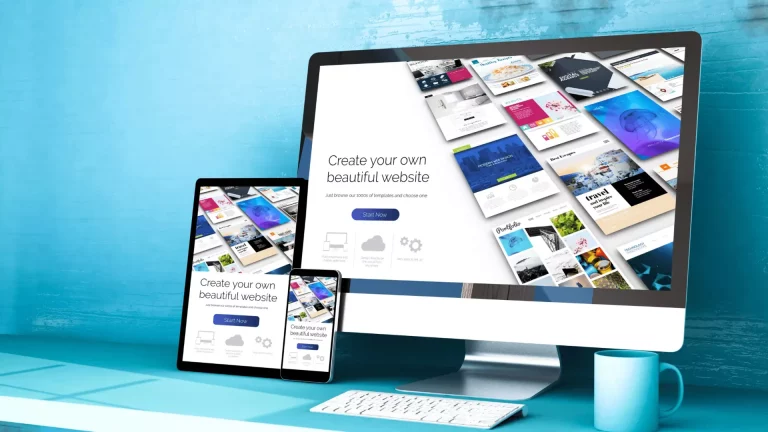A curious individual, seeking a solution to their problem, starts their online journey. They click, scroll, and explore the vast digital realm, and suddenly, they stumble upon your website. This encounter is not just a chance meeting; it’s an opportunity for your website to become the bridge between their needs and your solutions. The design of your website becomes the storyteller, captivating their attention, and inviting them to explore further. In the pages that follow, we’ll unravel ten tips that will transform your website into a customer magnet.
From empathizing with your audience to creating seamless user experiences, these strategies will help your website not only attract new customers but also keep them coming back for more. So, let’s embark on this journey into the world of customer-centric web design, where your website becomes the hero of our digital story.
Know Your Target Audience:
To design a website that truly resonates with your audience, you must first define your ideal customer. Who are they? What are their needs, preferences, and pain points? By creating a detailed profile of your ideal customer, you’ll gain valuable insights that will guide your design choices.
Market research is the key to understanding your audience on a broader scale. It involves studying your competitors, analyzing trends, and collecting data on consumer behavior. This research arms you with the knowledge needed to tailor your website to meet your audience’s expectations and outshine your competitors.
Remember, a well-designed website starts with a deep understanding of the people you want to attract.
User-Friendly Navigation:
When it comes to website design, user-friendly navigation is paramount.
Your website’s menu should be like a roadmap, guiding visitors effortlessly. It should be organized logically, with clear labels, so that users can find what they’re looking for without frustration.
CTAs are signposts that tell your visitors what action to take next. They should be prominent, concise, and action-oriented, making it crystal clear what you want your users to do, whether it’s “Buy Now,” “Learn More,” or “Contact Us.”
In today’s mobile-centric world, your website must be responsive. It should adapt seamlessly to different devices and screen sizes. Mobile users should enjoy the same smooth experience as those on a desktop.
Note: A user-friendly website navigation ensures that visitors stay engaged and can easily explore what you have to offer.
Visual Design Elements:
A visually appealing website can leave a lasting impression on your visitors.
The colors you choose should reflect your brand personality and resonate with your target audience. Consistency in color usage throughout your site helps in creating a cohesive and memorable visual experience.
Typography plays a significant role in readability and aesthetics. Select fonts that are easy to read and align with your brand’s tone. Maintaining consistency in font usage ensures a polished and professional appearance.
Images and graphics should be high-quality and relevant to your content. They enhance visual appeal and engage visitors. Avoid pixelation and ensure swift loading times for a seamless user experience.
The right visual design elements can make your website both visually appealing and effective in conveying your brand message.
Content Creation:
Engaging content is the heart and soul of your website.
Your homepage is the virtual front door of your business. Craft a compelling message that instantly communicates your value proposition and entices visitors to explore further.
Blogs are a powerful tool for showcasing your expertise and providing value to your audience. Regularly publishing informative and relevant blog posts can boost your credibility and keep visitors coming back for more.
If you’re selling products, clear and persuasive product descriptions are a must. Highlight the benefits, features, and uniqueness of your products to encourage conversions.
Visual content like videos and infographics can convey complex information in a digestible format. Use them strategically to engage and educate your audience.
Great content keeps your visitors engaged and coming back for more.
Website Speed and Performance
Speed matters when it comes to your website’s performance.
Your website’s loading speed can make or break user satisfaction. Slow-loading pages can deter visitors and impact your search engine rankings. Speed is critical for keeping your audience engaged.
Employ optimization techniques to ensure swift page loading. This includes image compression, code optimization, and content delivery network (CDN) usage. These techniques streamline your site’s performance.
Mobile users are a significant portion of your audience. Ensure that your website performs seamlessly on mobile devices. Mobile optimization enhances the user experience and accessibility.
Keep in mind that a fast and responsive website is essential for retaining visitors and achieving better search engine visibility.
Building Trust and Credibility:
Trust is the foundation of a successful online presence.
Showcase real customer testimonials and positive reviews. They serve as social proof, reassuring visitors that others have had a positive experience with your products or services.
Display trust badges and certifications prominently on your website. These symbols of trust, such as SSL certificates and industry affiliations, instill confidence in your website’s security and authenticity.
Prioritize privacy and security. Clearly communicate your data protection and privacy policies. Implement robust security measures to protect user information, enhancing trust.
Building trust and credibility is essential for establishing lasting relationships with your audience.
Social Media Integration:
Social media integration is a pivotal aspect of your website design strategy.
Your website design should seamlessly incorporate social media icons and sharing buttons. These design elements encourage visitors to connect with your brand on social platforms, strengthening your online presence.
The design of your website can also facilitate sharing and engagement. Well-placed social sharing buttons make it easy for visitors to share your content on their social networks, amplifying your reach.
By integrating social media effectively into your website design, you create a cohesive online experience that enhances brand trust and encourages interaction with your audience.
Email Marketing Integration:
Email marketing is a valuable tool for nurturing leads and maintaining customer relationships, and it’s closely tied to your website design.
Your website design should include strategically placed signup forms and pop-ups. These design elements make it easy for visitors to subscribe to your email list. By collecting email addresses through your website, you can build a valuable database of potential and existing customers.
The design of your email campaigns should align with your website’s visual identity. Consistency in design, from your website to your email templates, reinforces brand recognition and trust. An aesthetically pleasing and user-friendly email design enhances the overall customer experience.
Integrating email marketing into your website design streamlines the process of collecting leads and delivering targeted, visually appealing email campaigns, ultimately boosting engagement and conversions.
Analytics and Data Tracking:
Your website’s design plays a crucial role in optimizing user experience and conversions, and analytics and data tracking are essential tools to achieve this.
Incorporating ‘Google Analytics’ into your website design allows you to track visitor metrics, such as page views, bounce rates, and user demographics. This data helps you understand how users interact with your site and pinpoint areas that may need design improvements.
Website design influences user behavior, and tracking tools like heatmaps and user session recordings provide valuable insights. By analyzing how visitors navigate your site, you can identify design elements that are effective and areas that may require adjustments.
Informed decisions are at the core of successful website design. The data collected through analytics empowers you to make data-driven design choices, ultimately leading to a more user-friendly, engaging, and conversion-optimized website.
Analytics and data tracking into your website design ensures that your site continually evolves to meet the needs and preferences of your audience.
Legal and Compliance:
Website design isn’t just about aesthetics and functionality; it also involves adhering to legal and compliance standards.
Your website design should prominently feature a privacy policy that complies with regulations like the General Data Protection Regulation (GDPR). It’s essential to clearly inform visitors about data collection, storage, and usage practices, demonstrating your commitment to user privacy.
Website accessibility is a legal requirement, and your design should prioritize it. Ensure that your website is accessible to individuals with disabilities, including those with visual or hearing impairments. This includes using alt text for images, providing captions for videos, and implementing keyboard navigation.
Incorporating legal and compliance considerations into your website design safeguards your business from potential legal issues and ensures that your site is accessible to a diverse audience, promoting inclusivity and trust.
In Conclusion
In this comprehensive guide, we’ve explored the intricacies of designing a website that attracts and retains customers. From understanding your target audience to implementing user-friendly navigation, compelling content, and data-driven strategies, each facet of customer-centric web design has been discussed. It’s clear that your website’s design is not just about aesthetics; it’s a powerful tool for engaging your audience.
As the digital landscape continues to evolve, the future of customer-centric web design lies in continuous optimization and adherence to legal and compliance standards. To ensure your website remains effective and accessible, consider partnering with experts like Sariya IT, who specialize in web development services. Their expertise in creating compliant, user-friendly, and visually appealing websites will help your business thrive in an increasingly competitive online world.
In the end, a customer-centric approach to web design is not just a trend; it’s a fundamental strategy for success in the digital age.






